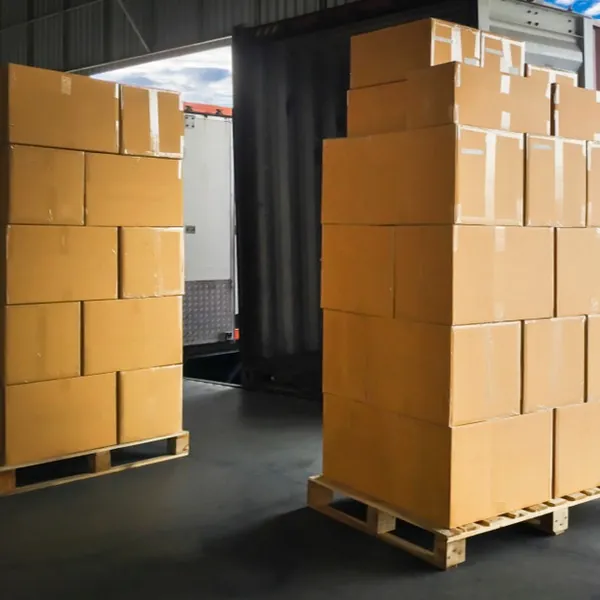
Get the Best Freight Shipping Rate
Discover how to get the best freight shipping rates with our expert tips. Learn about consolidating shipments, understanding carrier lanes, selecting the best carrier, and more. Maximize savings and efficiency with these valuable insights from FreightCenter.
How to get a Freight Shipping Rate
Regarding shipping, we’re all just trying to get the best freight shipping rate. We are all operating in a whole new environment these days. Staying stable and focusing on business continuity is undoubtedly high on most businesses’ lists, so now, more than ever, controlling your shipping costs and getting the best freight shipping rates are vital. But where do you start?
To help, we’ve compiled a handy list to give you a better idea of what to keep in mind to optimize the process and ensure that you always get the best freight shipping rate.
Thousands of businesses trust FreightCenter to move their freight faster, smarter, and cheaper! From unbeatable rates to top-notch service, our customers are raving about their shipping success.
See why they keep coming back!
Award-Winning Service, Trusted by Shippers Everywhere!
- 2021, 2017 & 2016 Food Logistics’ Top Green Providers
- 2021 & 2018 Supply & Demand Chain Executives’ Pros to Know: Matthew Brosious
- 2020 & 2019 Top Food Logistics’ 3PL & Cold Storage Provider Award
- 2020 & 2019 Business Observer’s Top 500 Companies on the Gulf Coast
- 2020 & 2017 SmartWay® Transport Partner
- 2020 & 2017 Food Logistics’ Champions: Rock Stars of the Supply Chain
- 2020 Best of Palm Harbor Awards for Local Businesses
- 2017 Green Supply Chain Award from Supply & Demand Chain Executive
- 2017 Tampa Bay Business Journal Heroes at Work
- 2016, 2015, & 2012 Food Logistics Top 100 Software and Technology Providers
- 2013 Tampa Bay Business 100 by Tampa Bay Business Journal
- 2013 Top 100 Great Supply Chain Partners by SupplyChainBrain
- 2012 TIA Samaritan Award Honorable Mention
- 2012, 2011 & 2010 TBBJ Fast 50 Recipient
- 2013, 2011, & 2010 Diversity Business Top Businesses

Why Choose FreightCenter?
Expertise in Freight Shipping: With over 25 years in the logistics industry, FreightCenter is dedicated to guiding you through the entire logistics process, from beginning to end. Our goal is to make freight shipping easy to understand and book. Don’t waste time researching and receiving quotes from individual carriers- FreightCenter’s got your back!
Competitive Rates with Tailored Solutions: We prioritize high-quality customer service without breaking your wallet. We utilize our relationships with regional and national carriers to offer you competitive, affordable rates while providing personalized solutions to your needs. Need a liftgate? We got you! Want to expedite your order? Leave it to us! We’re ready to provide tailored solutions that don’t compromise your freight shipment.
Personalized Customer Support: FreightCenter is committed to satisfying our customers. Our friendly customer support team is here to help you every step of the way, from initial inquiries to post-shipment concerns. We handle all aspects of logistics, including tracking, paperwork, and communication with carriers, so you can focus on your business while we manage your shipment. Choose us for our reliable service and affordable quotes!
10. Consolidate Shipping
Do you ship to and from the same location regularly? If so, consider consolidating your shipments into larger, less frequent shipments whenever possible.
Our in-depth analysis of thousands of shipments shows that the average shipper can save up to 90%—on average—by consolidating their shipments.
Stacking boxes on top of one another can help achieve this. For example, stacking and shrink-wrapping 10 similar-sized boxes onto a single pallet (rather than shipping them individually) has great benefits. You will save money on shipping costs, and you will save time by only needing to track one shipment rather than the usual ten.
9. Understand Carrier Lanes (Freight Route Imbalances)
Carrier lanes, or freight route imbalances, impact the rate you will pay for your shipment. The two most commonly used terms, head haul, and backhaul refer to the leg of the trip and understanding each term is important in getting the best shipping rate.
- Head haul refers to the initial shipment or the order that gets the truck on the road in the first place. Carriers charge a premium for head haul because they don’t have any other business in the head haul lane. Their other trucks are often already full.
- Backhaul lane is cargo that is shipped on the return trip. No carrier wants to be paying for an empty trailer, so backhaul rates are typically significantly discounted.
8. Understand Carrier Liability
Recently, a customer came to FreightCenter after their current carrier paid them only $200 when a shipment valued at $10,000 was damaged during transit. Their unhappiness was understandable and also avoidable. The client didn’t fully understand the carrier’s liability coverage, and therefore, the client didn’t get the necessary additional freight insurance.
A 3PL (third-party logistics company) can help shippers understand their liability coverage needs. 3PLs understand the specific limitations of each carrier’s limited liability policy and will make recommendations to add additional insurance through a licensed insurance company to ensure the proper value of an item is covered. Freight damage is common during transit due to frequent stops, loading, and unloading. Therefore, having proper insurance coverage is an important part of the shipping equation.
7. Selecting the Best Carrier for Your Route
Regional or national carrier? It’s important to realize that individual carriers price freight differently, depending on where you are shipping to or from. Carriers transport freight similarly to how airlines transport people. Each carrier has its own hubs and routes (known as “lanes”). Just as airfares can fluctuate greatly based on the placement of their hubs and the routes between them, so can carrier rates.
Certain carriers are excellent national freight carriers and are great choices for long, cross-country hauls. On the other hand, regional carriers are better for shorter, regional shipments. Oftentimes regional carriers are faster and less expensive for shipments that are travelling a short distance.
6. Minimize Empty Space on a Pallet
Reducing the freight class and minimizing oversize fees on your shipment are two simple ways to save money. To get the freight class as low as possible, make sure the pallet is packed to be as dense as it can be and with no empty space. Tightly pack the pallet edge to edge, but do not exceed the footprint of the pallet.
Also, avoid exceeding 60 inches in height whenever possible. Eliminate the unpleasant surprise of getting any additional freight charges by making sure the height of your shipment doesn’t go over 60 inches – that’s when oversize fees kick in.
5. Stackable Is the Trick
It is not uncommon for shippers to place a pyramid or something similar on top of a pallet. That prevents the carrier from stacking another item on top and the carrier will label the freight as being “non-stackable”.
This interferes with trailer volume efficiency and requires the carrier to use additional space for the shipment, often resulting in the shipper paying for both spaces. Make sure you leave your shipment stackable.
4. Spot Pricing Vs. Freight Shipping Rates
There are times when additional discounts can be found. For example, if your shipment is taking up more than 6 pallet spaces and weighs more than 5,000lbs, your 3PL can often check its carrier network to see if a carrier is willing to offer a one-time special rate for your shipment. This is what we refer to as a spot rate, and it’s based on the carrier’s available capacity. A discount such as this can be the difference in hundreds of dollars for your freight shipping rate.
3. Understanding Carriers’ Rules Tariffs
Most carriers have huge and complex books outlining all hidden fees and rules that could affect your shipping costs. This is what we call their Rules Tariff. Several factors that can influence these fees. For example, some zip codes have an additional pickup or delivery fees and locational surcharges, such as residential fees or limited access charges. Cities with heavy traffic, such as Chicago or New York City, have additional fees due to vehicle congestion. These fees can be as high as $300!
Again, working with a 3PL helps clients to better understand these hidden fees by comparing them side-by-side.
2. Net Cost Vs Line Haul Rate
When you compare different freight carrier shipping rates and try to find the lowest rate, you might look just at the Line Haul Rates and not any additional fees such as fuel surcharge and carrier rules fees as discussed in #3 above.
Discounts can be very misleading. The Line Haul Rates vary greatly from one carrier to another. It is not uncommon for a freight carrier that gives a 60% off their Line Haul rate to be substantially less than a carrier offering an 85% discount.
Once again, having a partner or 3PL can remove the complexity and can help you look at the Net Cost versus the Line Haul rate. When you get a quote, you can see the Net Cost of one carrier versus another.
1. Work with a Third-Party Logistics Provider (3PL)
Leverage the expertise and powerful technology that 3PLs have at their fingertips. Selecting the best option for your shipment can be complicated. Most 3PLs have access to TMS software that can not only find the best rates but can compare the pros and cons of each carrier.
As a 3PL, we have access to the best shipping rates and can help you navigate all of the complicated questions that can be associated with freight shipping. Don’t go at it alone – ask the experts! We help our clients find the best carrier to match their needs and budget.
Ready to get started? Instantly compare quotes with our free TMS, or give us a call at 800-716-7608 to speak with one of our shipping agents today.
To create value for our customers by delivering customized shipping solutions that meet their unique needs and to fulfill shipping demands from simple to complex with expertise, guidance and ingenuity.
Rail shipping is a cost-effective and environmentally friendly transportation method that utilizes trains to move goods over long distances. It's known for its efficiency in handling large volumes of cargo, making it a sustainable and economical choice for businesses seeking reliable freight transport options.
Expedited shipping is a premium service designed to meet urgent delivery needs. It prioritizes speed and quick turnaround, ensuring that packages or goods reach their destination faster than standard shipping options. Expedited shipping is the go-to choice when time-sensitive deliveries are essential, providing businesses and individuals with reliable and prompt service for critical shipments.
White glove shipping is a premium service that goes beyond standard delivery, offering meticulous handling, specialized packaging, and in-home setup or installation for valuable or delicate items, ensuring a seamless and hassle-free experience for customers.
Less than truckload (LTL) shipping is a smart logistics solution for businesses with smaller shipments. It combines multiple smaller shipments into a single truckload, optimizing space and reducing costs. LTL shipping offers affordability and efficiency while ensuring timely delivery, making it an ideal choice for companies looking to save on transportation expenses without compromising on service quality.


Frequently Asked Questions
Q. How can I get the cheapest freight shipping rates?
To secure the best rates, compare multiple carriers, consolidate shipments, choose the right freight class, and avoid accessorial fees by accurately describing your shipping needs. Booking in advance also helps reduce costs.
Q. When is the best time to book freight shipments?
Booking freight as early as possible can help you lock in better rates. Last-minute bookings often result in higher costs due to carrier availability.
Q. Do freight brokers like FreightCenter offer better rates than booking directly with carriers?
Freight brokers often negotiate discounted rates with multiple carriers, offering savings and additional services that might not be available when booking directly.
Q. Does freight class impact shipping rates?
Absolutely. Choosing the correct freight class ensures you’re not overpaying or underpaying. An accurate freight class avoids costly reclassification fees.
Q. How do I avoid extra fees on my freight shipment?
Avoid additional charges by providing accurate information about the shipment, such as dimensions, weight, and delivery requirements (e.g., liftgate or residential delivery). Planning ahead can also minimize accessorial fees.
Three Perks of Working With FreightCenter

25 Years in the Business
We have over 25 years of experience, as evidenced by our large network of professional carriers. Our knowledgeable team of shipping experts is ready to help you optimize your small business for the intricate world of logistics.

Customizable Shipping Options
Need a liftgate? No problem! Need to ship your products quickly? We got you covered! Our FreightCenter agents can offer you tailored solutions for your specific shipping needs, no matter what kind of small business you are.

Amazing Customer Care
Our customer support team has the answers to many of your shipping questions and concerns. We’re here to help you through every step of the shipping process, from initial inquiries to post-shipment issues.


